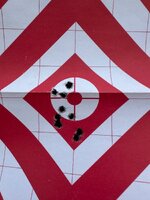Hey Jordan, that’s new to me, I would appreciate any more information or a link to such please
Sure, no problem.
Gyroscopic stabilization overcomes perturbations and asymmetries where the center of pressure of the projectile is in front of its center of mass. If you fired a bullet in a perfect vacuum, flying perfectly straight (ignoring any perturbation caused by the expanding gas as the bullet leaves the muzzle), it would remain straight even if it wasn't rotating at all. The reason that the scenario changes in atmosphere is because of drag forces imparted by the air on the bullet. Those drag forces are highest at the front of the bullet, while the majority of the mass, and therefore inertia, is located at the rear of the bullet. The natural tendency is for the bullet to swap ends because the "lighter" end of the bullet gets pushed around by drag more than does the "heavy" end. By spinning the bullet and imparting angular momentum, the bullet resists this "end-swapping" force, since a certain amount of overturning torque is required to destabilize the bullet (for a stable bullet, this torque threshold is more than the torque generated by the drag force).
Now, drag force is a function of the density of the medium through which the object is travelling. If you've ever tried wakeboarding, you'll know that when you're in the water and the boat is trying to pull you up, it requires a fair bit of effort to keep the wakeboard in front of you and get up out of the water, even though you're not going very fast at the beginning. This is because your center of pressure is out in front, close to the wakeboard, while your center of mass is rearward, somewhere near the center of your body, combined with the density of the water through which you're trying to plow. You can imagine that if you were doing the same thing in air, instead of in water, you'd have to go a lot faster to feel the same force trying to push your wakeboard behind you and pull you on your face (i.e., overturning torque). That's because air is much less dense than water.
The same thing applies to bullets. The more dense the air, the more overturning torque is applied to the bullet by the drag force, and the more angular momentum the bullet requires to overcome that torque. So you have to spin the bullet faster to maintain the same stability. In external ballistics, the entire reason that we care about atmospheric quantities, such as pressure, humidity, temperature, and derivative quantities like density altitude, is because they allow us to quantify air density, which affects not only stability, but the bullet's trajectory (both elevation and windage), as well.
Bryan Litz has discussed this in his book
Modern Advancements to Long Range Shooting. You can find more info here:
https://bergerbullets.com/the-state-of-the-art-in-rifle-bullet-stability/
